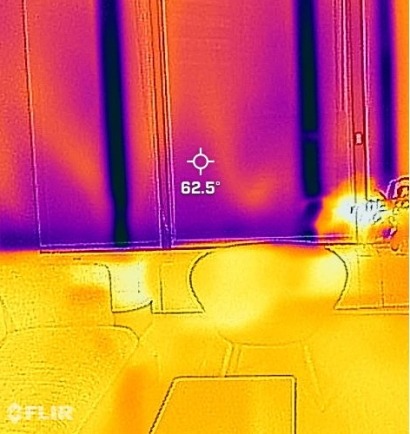
According to a ComEd-funded study, led by Illinois Institute of Technology Assistant Professor of Architectural Engineering Mohammad Heidarinejad, and conducted at Willis Tower in Chicago, in some buildings, the energy savings of heating and cooling as a result of automated shades are high enough to pay back the cost of installation within three to five years.
Temperature regulation accounts for a major portion of the energy used by buildings, typically 30–40 percent in climates similar to Chicago.
“It’s a major problem,” says Heidarinejad, “If you’re designing a new building, you have a lot of freedom to look at new technologies that save on energy consumption, but for existing buildings, you have limited options.”
Heidarinejad and his colleagues realized that while most existing shade solutions focus on adjusting the amount of light that transmits into buildings, insulating window shades could provide significant energy savings if connected to a system that provided greater control over when shades are opened or closed.
The general idea is similar to innovations in lighting, with many buildings using less electricity by putting lights on a fixed schedule or connected to motion sensors. Equivalently, shades provide maximum energy savings when closed, so a system that keeps the shades closed whenever building occupants don’t need them open will maximize energy savings.
With single-paned windows and a high window-to-wall ratio, Willis Tower is the style of building that stands to most benefit from this type of solution.
Heidarinejad, working with a collaborative research team at Illinois Tech, Parata Solutions LLC, and Amatis Controls, designed and implemented a study in the Equity Office at Willis Tower to test several control strategies for Parata’s patented insulating shades and to determine which provided the best combination of energy savings and functionality for office occupants.
Over the course of 10 months, the research team tested three control sequences for the shades.
The first strategy was fully manual, with occupants having complete control over when the shades were up or down. The other two strategies used automated controls: one opened and closed the shades on a predefined schedule and the other used sensors to consider factors such as outdoor conditions and room occupancy to determine if a shade should be opened or closed.
“The control strategies and the sequences that we tested were very, very novel,” says Heidarinejad.
The team compared the energy use for the different strategies and found that the use of the motorized shades provided around a 25 percent decrease in energy use during both heating and cooling seasons.
Importantly, the team also surveyed office users throughout the study in order to evaluate their thoughts about the installation and the new shades’ effectiveness.
“You want to make sure that you work together with the occupant and understand their needs. Without that, I don’t think any real savings could be sustainable,” he says. “In this case, the results were overwhelmingly favorable. Eighty percent said they prefer the new shades compared to the old blinds.”
Jongki Lee (Ph.D. ARCE Candidate) analyzed the survey and found that occupants preferred the manual or scheduled control strategies over the dynamic one, citing a desire that shades be open to benefit from daylight and the view.
As such, one of these control strategies with additional features tracking the occupancy of a room could be developed to balance user preference and building energy savings.
Heidarinejad says he thinks novel implementations of common technologies are an excellent area for exploration. Just as the LED light bulb innovated energy savings for lighting, he believes controlled shades could provide game-changing energy savings for heating and cooling.
“A lot of times a new vision of existing technology can deliver significant energy saving for a building. We had a new vision here, and we showed significant savings for this technology,” says Heidarinejad. “For an existing building, I would say it’s very good in terms of the savings you could get.”
“Working with Mohammad Heidarinejad and his team at Illinois Institute of Technology was a game changer for our company. Their rigorous field measurements helped confirm the efficacy of our shade system to drastically reduce energy use while offering a solution that occupants and building owners prefer over the incumbent,” says CEO of Parata Solutions, LLC, Christopher Nurre.
Heidarinejad says he hopes to conduct further field studies under different conditions such as buildings that use natural gas, buildings in different climates, in windows facing different directions, or upgrading the shades in an entire building.
Additional Illinois Tech researchers that contributed to the project include Akram Syed Ali (M.S. ARCE ’15, Ph.D. ARCE ’21), Afshin Farmarzi (Ph.D. CE ’21), Urwa Irfan (ARCE ’22), Christopher Riley (ME ’18, M.S. ARCE ’22), and Brianna Galvan (ARCE, M.Eng. ARCE ’21).
“We had students doing instrumentation, data collection, and modeling and their results were implemented in the actual build study,” says Heidarinejad. “It was important for the students to learn how to collaborate on a real project.”
“In addition to the exciting findings of energy savings and payback period, this project served as a perfect example of the type of industry-relevant research we enjoy—combining field measurements and computer simulations to evaluate a unique strategy to save energy in one of the most famous buildings in the world,” says Brent Stephens, Arthur W. Hill Endowed Chair in Sustainability, a co-principal investigator on the project.
Information provided by Illinois Institue of Technology
Disclaimer: “Research reported in this story was supported by the Commonwealth Edison Company. This content is solely the responsibility of IIT and does not necessarily represent the official views of the Commonwealth Edison Company.”

